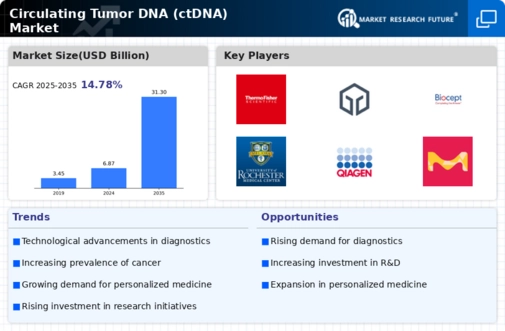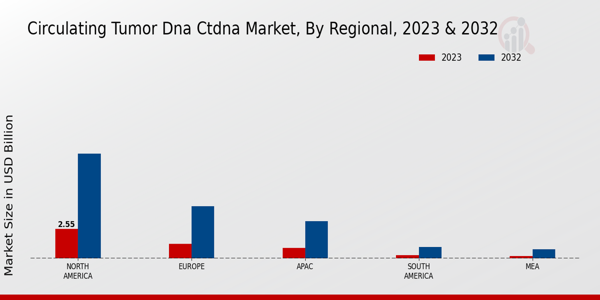Market Growth Projections
The Global Circulating Tumor DNA (ctDNA) Market Industry is anticipated to experience robust growth, with projections indicating a rise from 6.87 USD Billion in 2024 to 31.3 USD Billion by 2035. This growth trajectory reflects a compound annual growth rate (CAGR) of 14.77% from 2025 to 2035. Such projections underscore the increasing recognition of ctDNA as a pivotal tool in oncology, facilitating early detection, monitoring, and treatment personalization. The market's expansion is likely to be driven by technological advancements, rising cancer incidence, and the growing demand for precision medicine, positioning ctDNA as a cornerstone in future cancer management strategies.
Increasing Cancer Incidence
The rising incidence of cancer globally is a primary driver for the Global Circulating Tumor DNA (ctDNA) Market Industry. As per recent statistics, cancer cases are projected to increase significantly, leading to a heightened demand for advanced diagnostic tools. ctDNA testing offers a non-invasive method for cancer detection and monitoring, which is becoming increasingly vital in oncology. This trend is expected to contribute to the market's growth, with the industry projected to reach 6.87 USD Billion in 2024. The ability of ctDNA to provide real-time insights into tumor dynamics further enhances its appeal in clinical settings.
Rising Investment in Cancer Research
The surge in investment for cancer research is a significant catalyst for the Global Circulating Tumor DNA (ctDNA) Market Industry. Increased funding from both public and private sectors is directed towards innovative cancer diagnostics and therapeutics, including ctDNA technologies. This financial support fosters research and development, leading to the discovery of new applications and enhancements in ctDNA testing methodologies. As research progresses, the market is likely to benefit from novel findings that improve the accuracy and utility of ctDNA in clinical settings. The ongoing commitment to cancer research is expected to sustain market momentum and drive future growth.
Growing Demand for Personalized Medicine
The shift towards personalized medicine is significantly influencing the Global Circulating Tumor DNA (ctDNA) Market Industry. As healthcare evolves, there is a growing emphasis on tailoring treatments to individual patient profiles, which ctDNA testing facilitates. By providing insights into tumor genetics, ctDNA allows for more informed treatment decisions, potentially improving patient outcomes. This trend aligns with the broader movement towards precision oncology, where therapies are customized based on genetic information. The market is expected to experience a compound annual growth rate (CAGR) of 14.77% from 2025 to 2035, reflecting the increasing adoption of personalized approaches in cancer care.
Technological Advancements in ctDNA Analysis
Technological innovations in ctDNA analysis are propelling the Global Circulating Tumor DNA (ctDNA) Market Industry forward. Advances in sequencing technologies, such as next-generation sequencing (NGS), have improved the sensitivity and specificity of ctDNA detection. These advancements enable clinicians to detect minimal residual disease and monitor treatment responses more effectively. As a result, the market is poised for substantial growth, with projections indicating a rise to 31.3 USD Billion by 2035. The ongoing development of novel platforms and methodologies is likely to enhance the utility of ctDNA in personalized medicine, thereby expanding its application in various cancer types.
Regulatory Support and Reimbursement Policies
Regulatory support and favorable reimbursement policies are crucial drivers for the Global Circulating Tumor DNA (ctDNA) Market Industry. Governments and health authorities are increasingly recognizing the value of ctDNA testing in cancer management, leading to the establishment of guidelines and frameworks that facilitate its integration into clinical practice. Additionally, reimbursement policies that cover ctDNA tests are becoming more prevalent, making these diagnostics more accessible to patients. This supportive environment is likely to encourage healthcare providers to adopt ctDNA testing, further driving market growth. As the industry matures, continued regulatory advancements are expected to bolster confidence in ctDNA applications.























